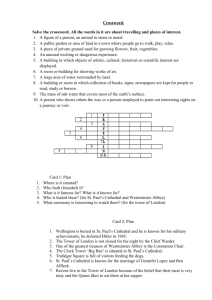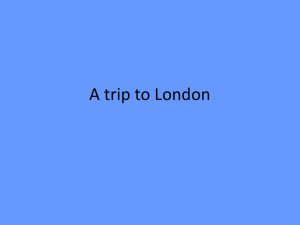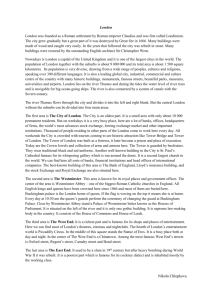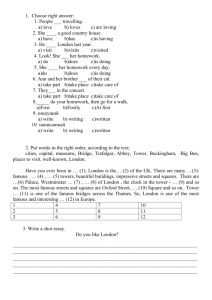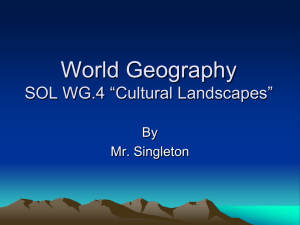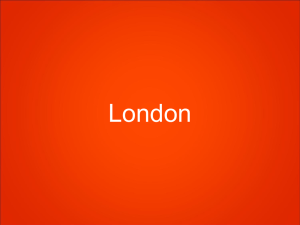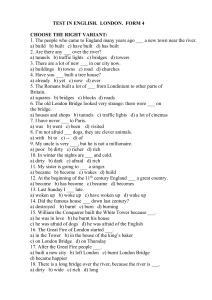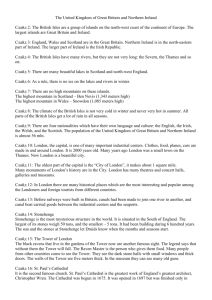Подорож до Лондона
advertisement
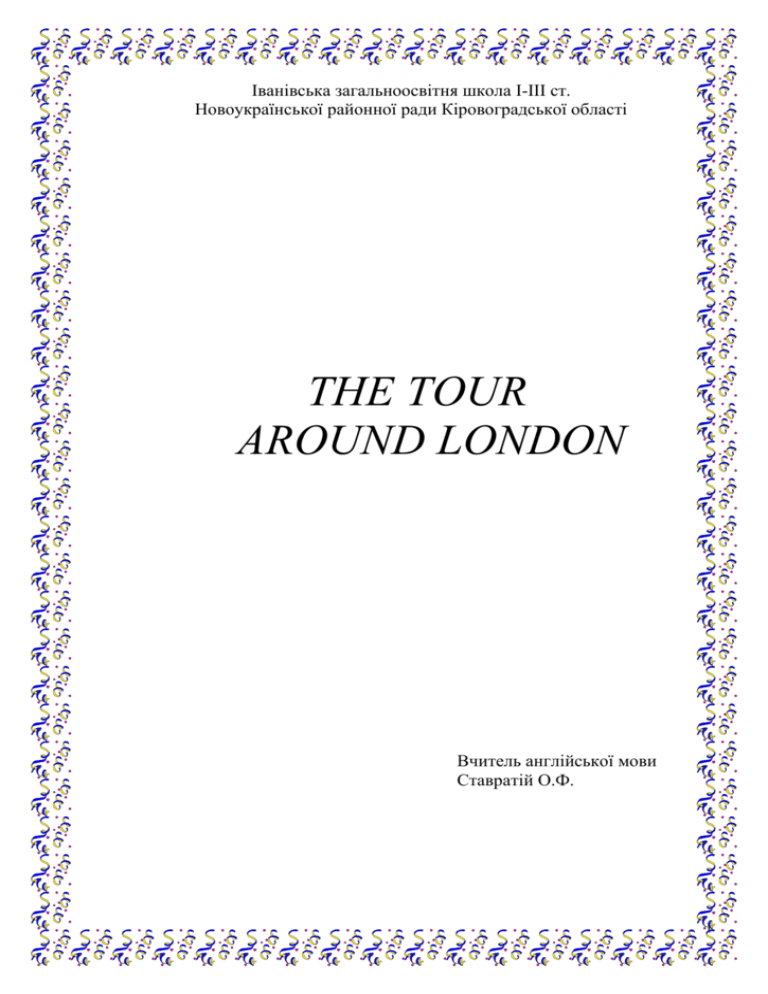
Іванівська загальноосвітня школа І-ІІІ ст. Новоукраїнської районної ради Кіровоградської області THE TOUR AROUND LONDON Вчитель англійської мови Ставратій О.Ф. 1 Тема уроку: THE TOUR AROUND LONDON Форма уроку: урок – подорож. Мета уроку: Практична: Тренувати навички мовленнєвої діяльність учнів, читання та аудіювання; розширити лексичний запас учнів, активізувати вживання лексики з теми у мовленні; вчити учнів добувати, аналізувати та використовувати отриману інформацію для реалізації комунікативних задач. Освітня: Ознайомити з новим країнознавчим матеріалом з теми «Лондон», розширити знання учнів про визначні місця столиці Великобританії; Зацікавити учнів культурним та історичним спадком народу, мова якого вивчається. Розвиваюча: Розвивати творчі здібності учнів; розвивати увагу, пам'ять, вміння порівнювати та узагальнювати матеріал, що вивчається; розвивати вміння висловлювати свою думку англійською мовою; Виховна: Виховувати повагу до культури та історії країни, мова якої вивчається; виховувати позитивне ставлення до вивчення іноземної мови; виховувати культуру поведінки і спілкування. Обладнання: Роздатковий матеріал: Комплект завдань з вправами до теми; Маршрут подорожі; Таблиця «Лондон»; Ілюстрації визначних місць Лондона та проекти по темі; ТЗН: Мультимедійний проектор; Презентаційний матеріал з теми: « Лондон». Література: англо-українські словники, книги «Лондон», «London». 2 План уроку І. Організаційний момент. (1 хв. ) ІІ. Мовленнєва зарядка. (2 хв.) 1. Бесіда T-P1P2 2. Мозковий штурм: Why do people travel? ІІІ. Повідомлення нової теми, мети та завдань уроку. Мотивація навчальної діяльності. (1 хв.) IV. Активізація опорних знань. (5 хв.) 1. Складання карти асоціацій. 2. Коло ідей. Обговорення питання: Why would so many people like to visit London? V. Опрацювання нової теми. (25 хв.) 1. Повідомлення маршруту подорожі. 2.Аудіювання: 1) введення нової лексики; 2)перегляд відео « Топ 10 найкрасивіших місць в Лондоні»; 3)обговорення побаченого. 3. Подорож по Сіті: 1) фонетична розминка; 2) повідомлення учнів про визначні місця Сіті; 3) перегляд фрагменту фільму про Сіті та його визначні місця; 4) виконання вправи на перевірку розуміння матеріалу: Exercise1. Mark the sentences True or False. 4.Прогулянка Вестмінстером: 1) Повідомлення екскурсоводів про Вестмінстер та його визначні місця; 2) перегляд фрагменту фільму; 3) виконання вправи на перевірку засвоєння матеріалу Exercise 2. Match the beginning and the ending of the sentences. 5. Огляд визначних місць Вест Енду: 1) Повідомлення екскурсоводів про район Вест Енд; 2) перегляд фрагменту фільму про Вест Енд; 3) виконання вправи на перевірку засвоєння матеріалу. Exercise 3. Which London sights do you associate with these words? 6. Відвідування Іст Енду: Повідомлення екскурсоводів про район Іст Енд. 3 VI. Узагальнення вивченого: (6 хв.) Виконання вправ: 1. Exercise 4. Watch the video 5 . What sights are you see? 2. Exercise 5. Guess the name of the sights. VII. Домашнє завдання: ( 3 хв). Диференційоване завдання: Підготувати проекти: 1 група (нижчий рівень). Ви-працівник туристичного агентства у Лондоні. Намалюйте рекламний постер цікавих, на Вашу думку, визначних місць у Лондоні, про які не йшла мова на уроці. 2 група ( вищий рівень). Ви відвідали Лондон і хочете написати листівку своему другу про вашу подорож. Скажіть, що вам сподобалось найбільше, наведіть цікаві факти. Намагайтеся зацікавити своїх друзів своєю розповіддю. VII. Підведення підсумків заняття. (2 хв.) PROCEDURE OF THE LESSON I. Introduction Teacher: Many people think that modern life is impossible without travelling. Travelling has completely changed our life, our knowledge about other people, their lifestyles and their culture. And I want to start our today’s lesson with some questions to you. II. Warming-up 1. Бесіда T – P1 P2 1) Do you like travelling? - (Yes, we like to travel!) 2) Where do you like to travel: in our country or abroad? – ( As for me, I like to travel abroad). 3) Where did you travel last time? What were your impressions? 2. Brainstorming: Why do people travel? - (People want to see a lot of interesting things in the world). III. Telling the students the topic and aims of the lesson. Well…Today we’ll make an imaginary trip to one of the most interesting and exciting city of the world, to London. We’ll learn new things about the history and modern life of the city, visit the most interesting sights of London, and watch video film. Of course, we’ll practice new words and expressions. You will have a chance to tell us what you know about the capital of the UK and its sights. 4 IV. 1. An association map Have you ever been to London? What do you associate London with? Let’s answer this question while making up an association map. LONDON 2. Circle of ideas: Why would so many people like to visit London? P. There are wonderful attractions, beautiful buildings, museums, parks and other things. V. Main part of the lesson: 1. Telling the rout of the trip Teacher: So, let’s start our imaginary trip. Have a look at our route. (слайд 1) History of London Visiting the City Walking round the Westminster Sightseeing in the West End Visiting the East End 2. Listening 1) Pre-listening task: Presenting vocabulary (слайд 2) To found – засновувати To call – називати Ancient[ eın∫ənt] – древній A trading centre – торговий центр Prosperous – процвітаючий Immense – величезний Appearance – поява Suburb – передмістя A sight [saıt]– визначне місце To go sightseeing – оглядати визначні місця To crown [kraun]– коронувати To bury ['berı]– хоронити Wealth – багатство Entertainment – розвага 5 2) Let's see the video “Top 10 Attractions London” (відео 1) 3) Post-watching task: 1) Do you like the video? Do you want to go there? – (Yes, I liked it. Yes, we would like to go there). 2) What was the most interesting fact for you? P1 - The most interesting fact is about The Tower of London. P2 - … about WESTMINSTER ABBEY. P3 - … about the most interesting London's sights. 3.Visiting the City 1) Phonetic drill The Teacher: Now London is one of the largest cities in the world. More than 10mln people live in London and its suburbs. London is a city of striking contrasts. Here one can come across the past and the present, the old and the modern, live side by side in mutual tolerance and respect. Today we’ll have an excursion round London and try to know as much as possible about its sights. First let’s practice in pronunciation of some proper names (слайд 3): The Tower of London Tower Bridge St. Paul’s Cathedral Westminster Abbey Trafalgar Square Buckingham Palace Downing Street Whitehall The Houses of Parliament Science Museum Hyde Park Millennium Bridge Christopher Wren Whispering Gallery No excursion can be held without a guide. Let me introduce our guides. They are Tanya Troyanska, Vladimir Yarmolenko, Vladimir Beskrovnii, Sergei Dundov. Guide 1: In London, one can see architecture of different centuries and styles. It is inseparably connected with the history of the city. Traditionally London is divided into several parts: the City, Westminster, the West End and the East End. The city first started in the place, which is known as the City. It is the oldest part and the Heart of London, it’s commercial and 6 business centre. It occupies a territory of a square mile. During a day, it is full of people, nearly a million people work there. 2) Students’ information about the Tower of London, Tower Bridge and St. Paul’s Cathedral TOWER OF LONDON AND TOWER BRIDGE The Tower of London long continued to be both a fortress and a palace. It was also a prison. At first prisoners were often foreign princes and nobles, who had been captured in war. But later on, in Tudor times, the Tower became the place where famous and the infamous people were sent. Nowadays the Tower is still a prison. Usually, a prison is a place where criminals are locked up. But in this prison the jewels are locked up. The jewels are the famous "crown jewels" of England. Crown jewels are treasures that belong to king or queen. According to tradition the Tower is guarded by the Yeoman Warders, or Beefeaters. They still wear their 16th century bright and colourful Tudor uniforms. And now we can talk about a Tower Bridge of London, London’s best known and most distinctive bridge has straddled the Thames for a century. The twin draw-bridges, each weighing about 1,000 tons, have been raised more than half a million times since the bridge was built. The Tower bridge is one of the most beautiful bridges across the Thames. Built in 1894, it is still in daily use. Even today Tower Bridge regulates a large part of the impressive traffic of the Port of London. ST. PAUL'S CATHEDRAL Everybody coming to London for the first time wants to see St. Paul's Cathedral. This is the third cathedral with this name which London has had. The two others were burnt down, the first in 1086 and the second in 1666. Christopher Wren was an architect who had already built many buildings. Now, in 1675, he started on his greatest work. For 35 years the building of St. Paul's Cathedral went on, and Wren was an old man before it was finished. From far away you can see the huge dome with a golden ball and cross on the top. The inside of the cathedral is very beautiful. After looking around, you can climb 263 steps to the Whispering Gallery, above the library, which runs round the dome. It is called this because if someone whispers close to the wall on one side, a person with an ear close to the wall on the other side can hear what is said. Then, if you climb another 118 steps, you will be able to stand outside the dome and look over London. 3) Watching the fragment of the film about the City and historical places of London. ( відео 2) 4) Post-watching task: 7 Exercise1. Mark the sentences True or False. Correct the false statements. (слайд 4) 1. The City is the money of London. 2. The City is the largest part of the capital. 3. The Tower of London is the first among the historic buildings of the city. 4. St. Paul’s Cathedral is one of the oldest buildings in London. 5. The Millennium Bridge is the most recognizable and one of the most beautiful bridges across the Thames. Key: 1F, 2F, 3T, 4F, 5F 4. Walking round the Westminster. 1) Teacher: So, we are going on our trip around London. We are coming to the next part of London, Westminster. Guide 2: Westminster is the historical and governmental part of London with Buckingham Palace which is the residence of Queen. Not very far from it there is Downing Street where for the last 200 years at house number 10 the Prime Minister of England has resided. Downing Street leads to Whitehall. It is the street of governmental offices. A little further we can see the Houses of Parliament. This is the place where the English Government – Parliament sits. 2) Watching the fragment of the film about Westminster. ( відео 3) 3) Post-watching task: (Слайд 5) Exercise 2. Match the beginning and the ending of the sentences 1. Buckingham Palace is 2. The Houses of Parliament is 3. Number 10 Downing Street is 4. Clock Tower is famous all over the world as 5. Westminster Abbey is a famous cathedral 6. Whitehall is a) the residence and office of the Prime Minister of the United Kingdom. b) a symbol of London and Britain as it contains a huge clock and a bell. c) the street of governmental offices. d) officially known as the Palace of Westminster. e) the London residence of the Sovereign. f) where almost all British monarchs have been crowned, married and buried since the 11th century. Key: 1e, 2d, 3a, 4b, 5f, 6c 6. Sightseeing in the West End. 8 1) Teacher: It’s time to visit the next part of London, The West End. Guide 1: The West End is the richest part of the city with its beautiful avenues, parks and gardens, grand hotels, theatres and fashionable shops. It is a symbol of wealth and luxury. It is the cultural and entertaining center. This part of London is very favorable for leisure and entertainment and that’s why it is often visited by tourists. 2) Watching the fragment about the West End. ( відео 4) 3) Post-watching task: (Слайд 6) Exercise 3. Which London sights do you associate with these words? 1. Pigeons, four bronze lions, two fountains, New Year’s Tree, Nelson’s Column. 2. Masterpieces of Renaissance, pictures of masters of all European Art School, a lot of art lovers. 3. A big reading hall; Egyptian, Greek, and Roman arts in all their branches, from pottery to sculpture. 4. 300 departments, delicious display, Egyptian escalator, stylish women’s and men’s wear. 5. 10 000 exhibits, the hall of technical progress, space gallery, “Who am I” exhibits. 6. Speaker’s corner, playing children, a lot of trees and flowers, beautiful ponds. 7. A lot of famous people, Chamber of Horror, Medieval criminals and execution scene. 7. Visiting the East End. Teacher: Without visiting the last part of London, the East End, our knowledge of London wouldn’t be complete. Guide 2: While the City is the money of London and the West End is the wealth of London, the East End is the hands of London that built the banks of the City and beautiful palaces and hotels of the West End. It is the industrial and the poorest part of London. It is a district, inhabited by the workers and dockers. There are many factories, plants and enterprises and the Port of London there. It is London about which the guide-book hasn’t much to say. Teacher: So, our trip is coming to its end. We well know that there is so much to see in London, that even Londoners can always find new places of interest. And it’s impossible to see and discuss all of them for such a short period. We’ll do it at the next lessons. 9 VI . Summing-up Exercise 4. Watch the video. What sights are you see? ( відео 5) Exercise 5. Guess the names of the sights: 1. You can see it from the river Thames. It’s very old. This place has a long and cruel history. It isn’t just one building. It has a history of blood – the blood of men, women and children. Now the Kings and the Queens of Britain don’t live there. (The Tower of London) 2. It’s the place where British kings and queens live when they are in London. When the Queen is inside you can see the flag over it. Important visitors often go to this place. They meet Queen Elizabeth and the royal family there. A lot of tourists go to visit this place. They stand outside and see the Changing of the Guard. (Buckingham Palace) 3. They stand beside the river Thames. You can also see them from Westminster Abbey. The country’s leaders speak at this place. The famous clock Big Ben stands near them. (The Houses of Parliament) 4. It’s one of the famous bridges across the Thames. It was built in 1894. It’s next to the Tower of London. It opens and ships go up and down the river Thames. (Tower Bridge) 5. This park is the property of the royal family. It is famous for its outdoor entertainments and its Speaker’s Corner. On a Sunday morning you can make a speech about something you believe to be very important. (Hyde Park) 6. It’s a place where different meetings take place. There are 2 fountains there. You can see many pigeons. In the middle of this square there is Nelson Column. (Trafalgar Square) 7. It’s a symbol of England. It isn’t far from the Houses of Parliament. The legend says that it was founded by St Peter himself. We know that it was built by King Edward in 1065. The coronation of all British Kings and Queens takes place there. Some famous people are also buried here. ( Westminster Abbey) 8. It’s one of the famous sights of London. You can meet great characters of history and art there. Actors, film stars, pop-singers and sportsmen come face to face with famous politicians. There is a special place for the Queen’s family. It has one of the largest collections of wax models in the world. (Madam Tussaud’s Museum) 5. Evaluating 6. Home task Make up projects: Group 1. You are a tourist agent in London. Draw advertising posters about the most interesting sights or places of London we haven't discussed Group 2. After visiting London you have an idea to write a letter to your friend . For the next lesson you should write a letter to your friend. Try to interest your friend. Find the most interesting facts and the most convincing arguments. 10

